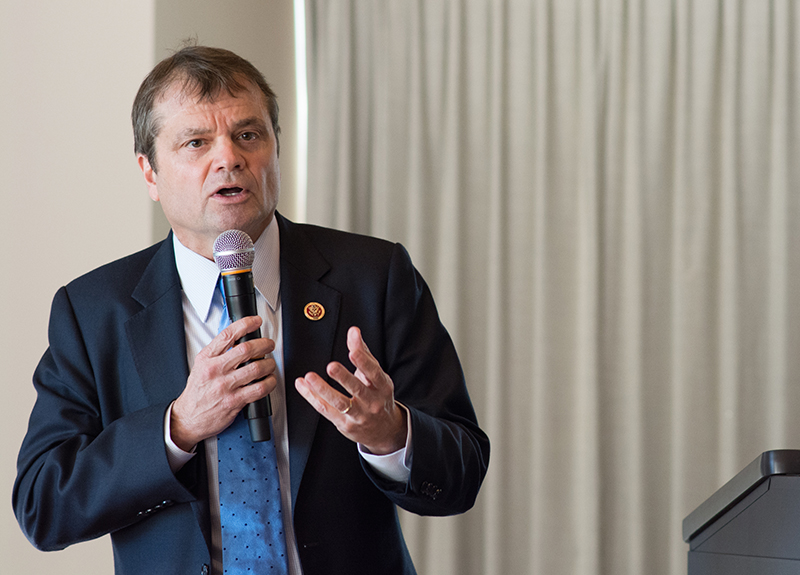Conveying the complexities of climate and water challenges – such as the nuances of scientific uncertainty, limits on forecasting behavior in dynamic natural systems, and predicting long-term impacts – is sometimes best achieved by keeping things elementary.
“If you have to explain, you’re in trouble,” said Congressman Mike Quigley (D-Ill.), the opening speaker at the 2016 Northwestern Climate Change Symposium. Relating a story of the American Clean Energy and Security Act of 2009 (the “Waxman-Markey Bill”), which proposed national cap-and-trade legislation, Quigley explained that opposing Republicans didn’t focus on climate; instead, they called it a tax bill and a jobs killer. “The issue was no longer climate change,” said Quigley. “In half a sentence...it flipped the whole issue.”
Symposium speakers provided solutions-oriented perspectives on challenges at the water-energy-climate nexus held Oct. 13. Major themes included the safe and reliable provision of water, management of the Great Lakes, prevention of urban flooding, and ensuring the sustainability of energy production.
“The symposium was structured to bridge the gap from information to action,” said Aaron Packman, director of the Northwestern Center for Water Research and professor of civil and environmental engineering in Northwestern’s McCormick School of Engineering and Applied Science. “The speakers provided attendees with an understanding of how water supply, energy production, and natural hazards interact with climate. Understanding how regional and local outcomes, such as Great Lakes water levels and urban flooding, can be addressed through a combination of federal action and local climate adaptation is a powerful tool for community resilience.”
Plenary sessions addressed national water-energy challenges. Mark Johnson, director of the U.S. Department of Energy’s Advanced Manufacturing Office (AMO), described clean energy and manufacturing as a “nexus of opportunity” that can be used to link economic competitiveness, energy security, and public health. Johnson presented a vision of the U.S. as a world-leader in innovative, high-tech manufacturing, creating new jobs and technologies in clean energy production and water treatment that can be exported globally. This will require ensuring the long-term reliability of water and energy supplies for high-tech industry. Diana Bauer, director of the U.S. Department of Energy’s Office of Energy Policy and Systems Analysis, emphasized that understanding change in energy and water systems is required for forward-looking technology investment and policy thinking.
Following through on opportunities for action, Jessica Hellman, director of the Institute on the Environment at the University of Minnesota, provided insight into adaptation strategies that will be needed to prepare cities and natural ecosystems for climate change. According to data compiled by the Global Adaptation Index, although the United States ranks 11th globally in its potential resilience to climate change, it falls to 37th when looking at the vulnerability of key ecosystems services such as coastal buffers to storm surges and pollinators that are important to food production. Drew Gronewald, of the Great Lakes Environmental Research Lab, described the volume, natural variability, and existing engineering controls on the Great Lakes as a critical potential regional buffer to the climate impact of changing water levels.
The final session, featuring Thomas Kunetz, assistant director of engineering at the Metropolitan Water Reclamation District of Greater Chicago (MWRD), and Harriet Festing, director of water programs at the Center for Neighborhood Technology (CNT), addressed engineering and policy actions being taken by governments and communities in the Chicago area to improve water management, reduce urban flooding, and better prepare for climate adaptation. MWRD is deploying innovative solutions to improve regional water resource management and reduce urban flooding. CNT is working directly with affected homeowners and communities to better document flood damage and implement local solutions to reduce these impacts. Both Kunetz and Festing emphasized the importance of local partnerships, such as current demonstration projects at schools and neighborhoods, in solving the flooding challenge.
Other symposium speakers included Joe Ryan, director of the Air-Water-Gas Sustainability Research Network at the University of Colorado, Boulder, and Bradley Sageman, professor and chair of the Northwestern department of earth and planetary sciences in the Weinberg College of Arts and Sciences.
Packman emphasized, “The solution to water, energy, and climate challenges starts in our homes, schools, and communities. This annual symposium program provides a way for Northwestern students and the Chicago-area public to get involved to solve both local and global challenges.”
“The time to act is now,” Quigley said. “The American public gets that. It wants to do something.”
Hellmann was even more direct: “We create the future.”
**
This year’s symposium was jointly sponsored by the Northwestern Center for Water Research, the Institute for Sustainability and Energy at Northwestern (ISEN), the Department of Earth and Planetary Sciences (EPS), and the Northwestern-Argonne Institute of Science and Engineering (NAISE). This is the sixth Northwestern Climate Change Symposium, an annual program inaugurated in 2009 by ISEN and EPS.



